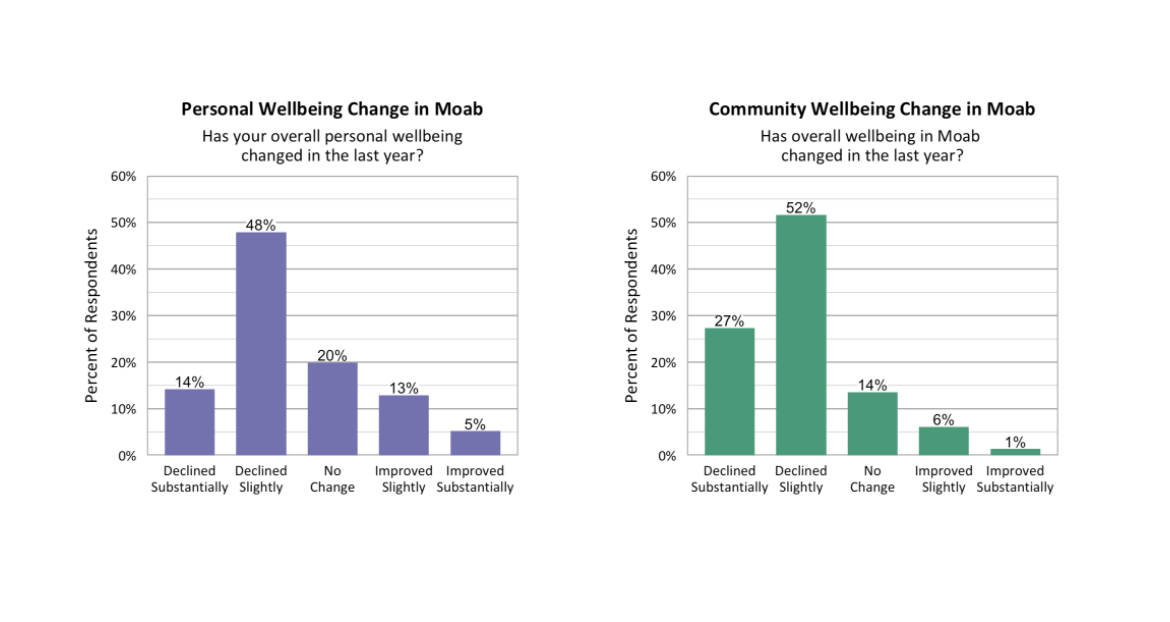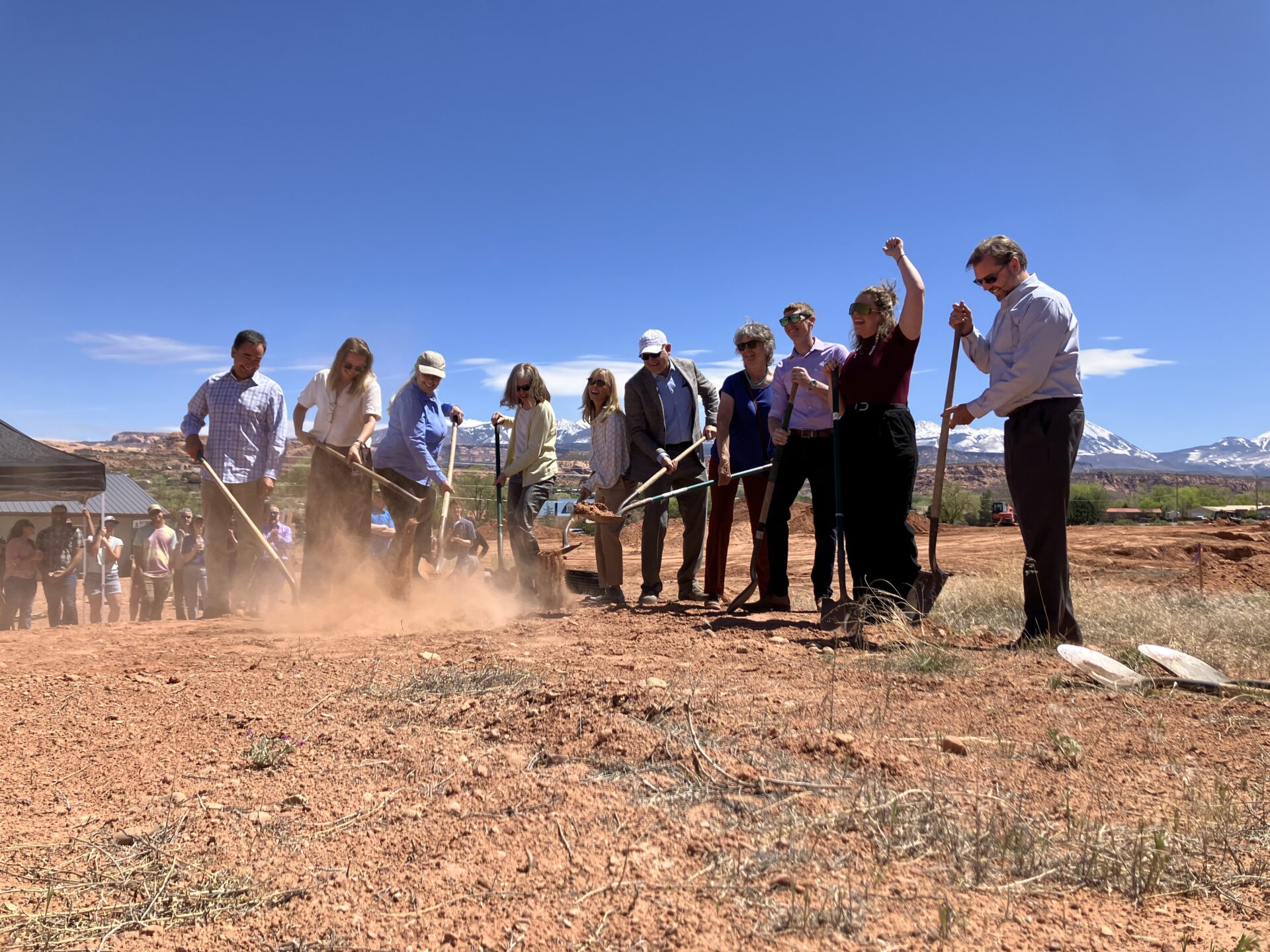Each year, Utah State University releases its Utah Wellbeing Survey in collaboration with the Utah League of Cities and Towns. The project aims to paint a more detailed picture of residents’ wellbeing in cities and towns across the state, with hopes that the collected data will ultimately improve the quality of life in these places.
The City of Moab opted to participate in this year’s Utah Wellbeing Survey. In January and February of this year, the city advertised the survey on various forms of media, including special media, local newspapers, radio and the city’s website. The Qualtrics survey was open to all Moab residents ages 18 and older.
Moab residents submitted 443 viable surveys in 2021, with 90% of the surveys fully completed — an increase from the 354 survey responses submitted in 2020. The submitted surveys represent approximately 10.6% of Moab’s adult community, as 4,167 legal adults live in Moab, according to the 2015-2019 American Community Survey.
Full-time Moab residents made up 93.9% of survey respondents, with 64.7% living in Moab City, 4.1% in Castle Valley and 28.1% in Spanish Valley. The average survey participant has lived in Moab for 18 years, though length of residency ranged from zero to 65 years, with 25.6% of respondents having lived in Moab for five years or less.
Compared to United States Census information from the 2015-2019 American Community Survey, survey participants are not fully representative of Moab City. Married female residents with a four-year college degree who own their own home were overrepresented, while residents ages 18 to 29 and residents with household incomes less than $25,000 each year were underrepresented. The Utah Wellbeing Survey did not weight responses to influence the survey’s findings, but organizers have said they will provide updates later in the year “to account for weighting by demographic characteristics.”
Moab’s Overall Personal Wellbeing and Community Wellbeing scored below average compared to the 29 other cities who participated in the survey. The survey measures 10 “wellbeing domains,” which survey participants rated on a five-point scale from “not at all important” to “very important.”
Mental health, physical health, local environmental quality, safety and security, connection to nature and leisure time were ranked as the wellbeing domains most important to survey participants. Overall, respondents said they valued Moab’s access to nature, community connection, small town feel, recreation and quiet and peacefulness.
The wellbeing domains in the red zone — aspects that Moab residents consider highly important but poorly executed — were mental health and local environmental quality. “Cultural opportunities” was the only wellbeing domain that had an average rating lower than 3.0.
Water supply, affordable housing, opportunities for youth, air quality, access to healthcare and access to public land were among respondents top concerns for the future of Moab. Some survey respondents filled in the “other” category for concerns in Moab: the most common “other” responses included off-road vehicles, tourism, tourist development and traffic.
The Utah League of Cities and Towns categorizes Moab as a “rural hub/resort community.” Compared to other cities in the same categorical cluster, Moab ranks below the cluster average in average overall personal wellbeing and average community wellbeing. Though Moab was not found to be statistically significantly better than other cities in this cluster in terms of overall personal wellbeing, the city is significantly lower in overall community wellbeing than Wellington, La Verkin, Helper and Richfield.
The 2021 Utah Wellbeing Survey’s findings specifically asked Moab residents how their wellbeing was impacted by the COVID-19 pandemic. The pandemic most strongly impacted social connections, cultural opportunities and mental health, according to survey participants. Connection to nature and leisure time improved, for 23% and 22% of participants, respectively.
Overall personal wellbeing declined for 62% of Moab residents in the past year, and was more likely to decline for female survey participants. Wellbeing in Moab during the last year decreased for 79% of survey respondents, and was more likely to decrease for female respondents and residents who have lived in Moab for longer than five years.
The survey also found that connection to nature, which increased for many respondents during the pandemic, declined for those without college degrees. Cultural opportunities were more likely to decline for those with college degrees and for Moab residents over 60 years of age. Mental health declined less significantly for male respondents and for respondents over 60 years of age.
Survey participants also rated their overall personal wellbeing and the overall community wellbeing in Moab on a scale from one to five, one meaning “very poor” and five meaning “excellent.” The average personal wellbeing was 3.82; 71% of respondents rated their wellbeing at a four or five on the scale. Personal wellbeing declined from an average score of 3.93 in the 2020 Utah Wellbeing Survey.
The average rating for community wellbeing in Moab was slightly lower this year at a score of 3.13, with only 35% of respondents rating community wellbeing at a four or five. Community wellbeing increased from an average score of 3.03 in the 2020 Utah Wellbeing Survey.
The survey asked participants to score community actions and community connection in Moab on a five-point scale, one meaning “not at all” and five meaning “a great deal.” Survey participants in Moab indicated that they thought residents took action on community issues and that feelings of community connection were strong, two categories that Moab scored higher in than other participating cities.
The average score for the degree to which Moab residents take action in response to local problems and opportunities was 3.32. The score for the degree to which participants felt connected to their community was a 3.16.
Moab residents over the age of 60, female residents, residents with a college degree and Latter-Day Saint residents had higher perceptions that the Moab community takes action in response to local problems and opportunities. Residents over the age of 60, with a college degree and with incomes over $100,000 gave higher scores of community connection in Moab. Moab ranked in the top five cities surveyed on perceived community action.
Moab survey participants averaged a score of 2.61 for community activeness, with most respondents indicating that their most common community activeness activities were contacting public officials and working with others on an issue.
Moab’s natural landscape is one of its major assets, attracting millions of visitors annually. Respondents ranked Moab’s natural landscapes as a “highly positive” quality of the city that had a significantly positive influence on residents’ wellbeing, particularly during the pandemic.
In contrast, commercial development and extractive industry in Moab’s natural landscapes were perceived to have a negative impact on residents’ wellbeing. Most survey participants indicated they were feeling Moab’s growing pains: 62% of survey respondents living in Moab felt that population growth in the city was happening too fast, and 73% felt that economic development was also happening too quickly.
Finally, the survey allowed participants to answer an open question about what they value most about Moab. Moab’s natural resources was the most common answer with 284 mentions, while 232 responses mentioned Moab’s social climate and 102 mentioned Moab’s wide range of activities.




